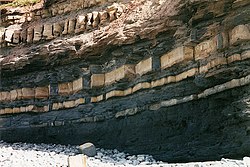Sinemurian
| Sinemurian | |||||||||
|---|---|---|---|---|---|---|---|---|---|
 Jurassic rock strata in the cliffs at East Quantoxhead, near the Sinemurian golden spike. | |||||||||
| Chronology | |||||||||
| |||||||||
| Etymology | |||||||||
| Name formality | Formal | ||||||||
| Usage information | |||||||||
| Celestial body | Earth | ||||||||
| Regional usage | Global (ICS) | ||||||||
| Time scale(s) used | ICS Time Scale | ||||||||
| Definition | |||||||||
| Chronological unit | Age | ||||||||
| Stratigraphic unit | Stage | ||||||||
| Time span formality | Formal | ||||||||
| Lower boundary definition | FAD of the Ammonites Vermiceras quantoxense and Vermiceras palmeri | ||||||||
| Lower boundary GSSP | East Quantoxhead, West Somerset, England, UK 51°11′27″N 3°14′11″W / 51.1909°N 3.2364°W | ||||||||
| Lower GSSP ratified | 2000[2] | ||||||||
| Upper boundary definition | FAD of the Ammonite species Bifericeras donovani and genus Apoderoceras | ||||||||
| Upper boundary GSSP | Robin Hood's Bay, Yorkshire, England, UK 54°24′25″N 0°29′51″W / 54.4069°N 0.4975°W | ||||||||
| Upper GSSP ratified | March 2005[3] | ||||||||
In the geologic timescale, the Sinemurian is an age and stage in the Early or Lower Jurassic Epoch or Series. It spans the time between 199.5 ±0.3 Ma and 192.9 ±0.3 Ma (million years ago).[4] The Sinemurian is preceded by the Hettangian and is followed by the Pliensbachian.[5]
In Europe the Sinemurian age, together with the Hettangian age, saw the deposition of the lower Lias, in Great Britain known as the Blue Lias.
Stratigraphic definitions
[edit]The Sinemurian Stage was defined and introduced into scientific literature by French palaeontologist Alcide d'Orbigny in 1842. It takes its name from the French town of Semur-en-Auxois, near Dijon. The calcareous soil formed from the Jurassic limestone of the region is in part responsible for the character of the classic Sancerre wines.
The base of the Sinemurian Stage is at the first appearance of the ammonite genera Vermiceras and Metophioceras in the stratigraphic record. A global reference profile (GSSP or golden spike) for the Sinemurian Stage is located in a cliff north of the hamlet of East Quantoxhead, 6 kilometers (3.7 mi) east of Watchet, Somerset, England.[6]

The top of the Sinemurian (the base of the Pliensbachian) is at the first appearances of the ammonite species Bifericeras donovani and ammonite genus Apoderoceras.
The Sinemurian contains six ammonite biozones in the Tethys domain:
- zone of Echioceras raricostatum
- zone of Oxynoticeras oxynotum
- zone of Asteroceras obtusum
- zone of Caenisites turneri
- zone of Arnioceras semicostatum
- zone of Arietites bucklandi
References
[edit]- ^ "International Chronostratigraphic Chart" (PDF). International Commission on Stratigraphy. December 2024. Retrieved January 1, 2025.
- ^ Bloos, Gert; Page, Kevin (March 2002). "Global Stratotype Section and Point for base of the Sinemurian Stage (Lower Jurassic)". Episodes. 25 (1): 22–28. doi:10.18814/epiiugs/2002/v25i1/003. Retrieved 23 December 2020.
- ^ Meister, Christian; Aberhan, Martin; Blau, Joachim; Dommergues, Jean-Louis; Feist-Burkhardt, Susanne; Hailwood, Ernie; Hart, Malcolm; Hesselbo, Stephen; Hounslow, Mark; Hylton, Mark; Martin, Nicol; Page, Kevin; Price, Greg (June 2006). "The Global Boundary Stratotype Section and Point (GSSP) for the base of the Pliensbachian Stage (Lower Jurassic), Wine Haven, Yorkshire, UK". Episodes. 29 (2): 93–106. doi:10.18814/epiiugs/2006/v29i2/003. Retrieved 23 December 2020.
- ^ Benton, Michael J. (2012). Prehistoric Life. Edinburgh, Scotland: Dorling Kindersley. pp. 44–45. ISBN 978-0-7566-9910-9.
- ^ For a detailed geologic timescale see Gradstein et al. (2004)
- ^ See for the description of the GSSP Bloos & Page (2001)
Sources
[edit]- Bloos, G. & Page, K.N.; 2001: Global Stratotype Section and Point for base of the Sinemurian Stage (Lower Jurassic), Episodes 25(1), pp. 22–28, PDF
- Gradstein, F.M.; Ogg, J.G. & Smith, A.G.; 2004: A Geologic Time Scale 2004, Cambridge University Press.
- d´Orbigny, A.C.V.M.D.; 1842: Paléontologie française. 1. Terrains oolitiques ou jurassiques, Bertrand, Paris. (in French)
See also
[edit]External links
[edit]- GeoWhen Database - Sinemurian
- Lower Jurassic timescale, at the website of the subcommission for stratigraphic information of the ICS
- Stratigraphic chart of the Lower Jurassic, at the website of Norges Network of offshore records of geology and stratigraphy


 French
French Deutsch
Deutsch